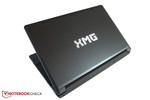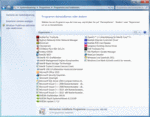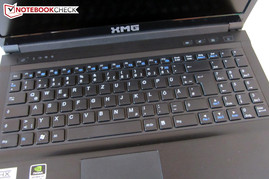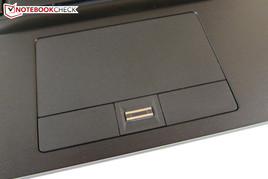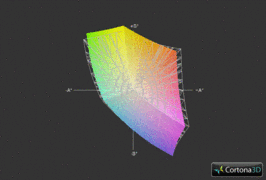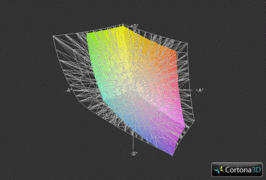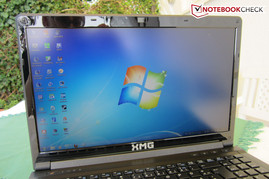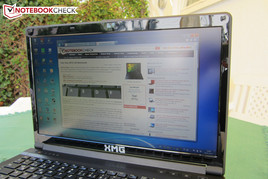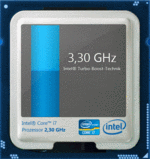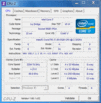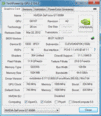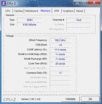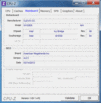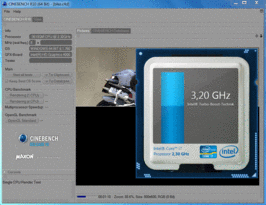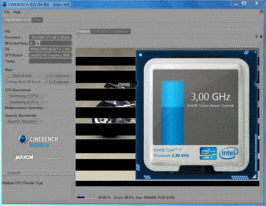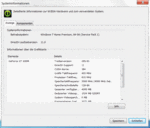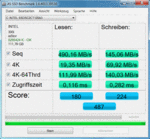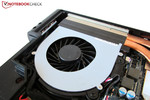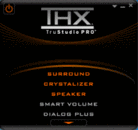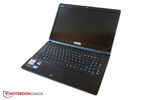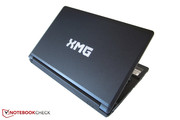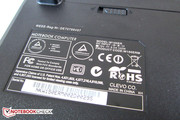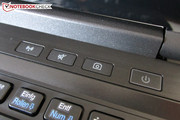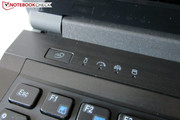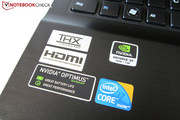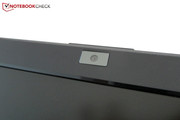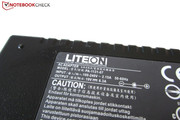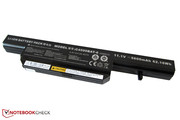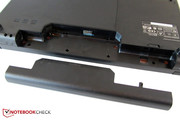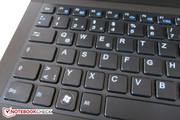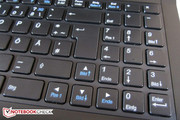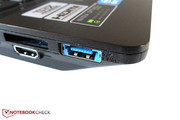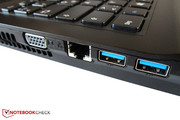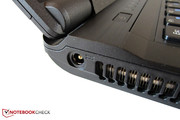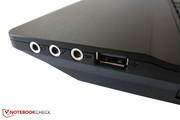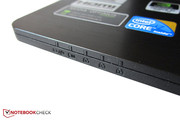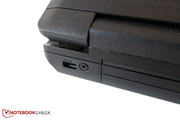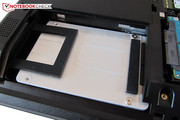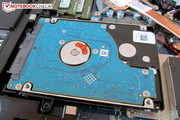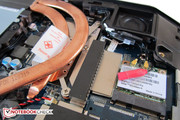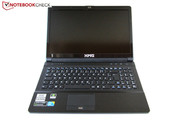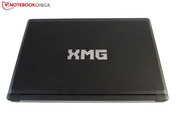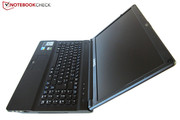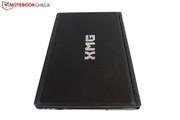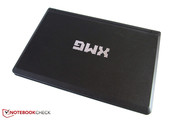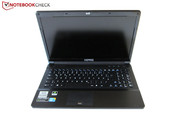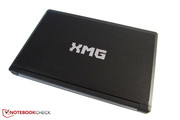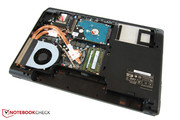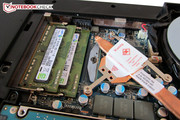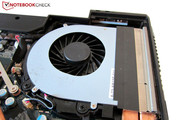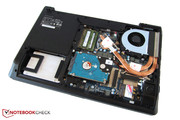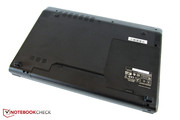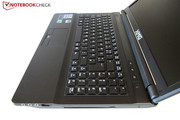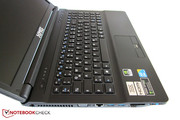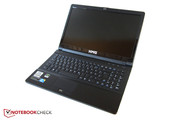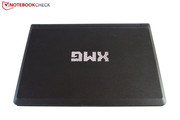Review Clevo W150ER Barebone Notebook
Judging by our forum, Schenker met the taste of the notebook community with the XMG A501. More than 100.000 clicks and 1600 comments prove that the powerful all-rounder with an attractive price is very popular. While other manufacturers put customers off with cheap and reflective displays, the 15-incher features a a high-end non-glare display. The GeForce GT 555M is also respectable for a mid-range notebook.
About a year after our in-depth review we could now examine the new model (pre series). While the XMG A502 largely looks like the predecessor, there is much new inside. It is based on Intel's current Chief River platform (HM76 chip set), which supports old Sandy Bridge processors and the new Ivy Bridge generation. Schenker offers all price categories from cheap dual-core solutions up to expensive quad cores. The GeForce GT 650M based on Nvidia's Kepler architecture, which already impressed with its energy efficiency in the One M73-20, is used as graphics card.
As the mainboard only features two memory slots a maximum of 16 GB DDR3 RAM is supported (most users will not require more than four or eight GB). We appreciate that two hard drives can be installed. The A501 required an ODD caddy for this. If you do not have enough money for a modern Solid State Drive, you can also select weaker HDDs or hybrid models. Entertainment fans will configure a Blu ray drive instead of a DVD burner. Super: Although Schenker Notebooks is located in Germany they offer various keyboard models. An operating system is not included in the basic package.
The A502 starts at 779 Euro (or 975 USD). According to current plans the device will be launched around 21st of May.
Case
Schenker do not produce the case themselves, but they use a chassis from the Taiwanese company Clevo. The W150ER barebones model only looks marginally different than the old W150HR.
Besides a redesigned front part, slightly thicker base plate, and different connectivity, the A501 resembles the A502. So, the new model has the same advantages and disadvantages.
It is above average in height. While most all-round laptops are about four centimeters high, the XMG A502 is nearly five centimeters. A weight of 2.9 kilogram (incl. two hard drives) is also much for a 15-inch device.
The buyer looks for metal surfaces in vain. The laptop is entirely made of plastics. Contrary to the matte keyboard surface and the glossy display frame (fingerprints!) the palm rests and lid have a roughened texture. Speaking of the lid: The shrunken XMG logo is now composed of only three stickers and no longer of many small ones.
We think that the build quality is fair. The case is solid and its stability is alright. The chassis has to be pressed quite heavily before it yields. The lid is not that flexural rigid, but this is not utterly important in practice.
The unobtrusive look is a matter of taste. Clevo, a barebones manufacturer, do not favor colorful LED-elements or noticeable colors. The dark gray chassis looks decent and timeless. Because of the stiff hinges the base unit lifts up when opening the lid.
Connectivity
Interfaces
The connectivity is superior. The right side houses an optical drive, a USB-2.0 port, and three audio jacks (headphones, microphone, S/PDIF). The rear only provides a Kensington Lock, the front no interfaces at all. Most of the ports are on the left side: power in, RJ-45 Gigabit LAN port, VGA, two USB-3.0-Ports, and an eSATA/USB-3.0 combo. Suboptimal: The HDMI output is directly below the 9-in-1 card reader.
The port distribution only partly convinced us. Since Clevo moved the fan further back, several ports are now closer to the front. Left handers will no longer experience that much heat, but attached cables might annoy.
Wireless Communication
The Bigfoot Killer Wireless-N 1102 Networks adapter is responsible for wireless data transfer. The mini-PCIe card supports WLAN a/b/g/n and features two antennas and a maximum transfer rate of 300 Mbit/s (2.4 + 5 GHz). The pre-installed Networks Manager displays a large amount of information and helps to configure it optimally. Unfortunately the module does not support Bluetooth.
Maintenance
Comfortable Maintenance is the one of the biggest advantages of the XMG A502. Regardless whether you wish to reach the cooler, CPU, GPU, RAM, WLAN module or mass storage: You just need to loosen two screws and remove the base plate.
Software
As usual Clevo did not install any bloatware. Thanks to Microsoft's Security Essentials and the Starter Edition of Office 2010 you should not require a special Office or antivirus software. Please find figures of the five BIOS menus below.
Accessories
The scope of delivery is typical for notebooks. In the plain box there are only a quick reference guide, a driver DVD and a Multimedia Suite software (Nero 10 Essentials). The 120 watt power adapter is 16 centimeters long, weighs 735 gram and is identical to the predecessor's. The 6-cell battery (330 gram) was not replaced either.
Warranty
The base warranty of two years can optionally be extended to three (Premium) or four years (Platinum). According to the home page it includes a Pickup-&-Return-Service (outside Germany only Bring-In) and an instant repair for several month. Other barebone reseller often only include one year warranty in the base price.
Input Devices
Keyboard
If you hoped for the backlit keyboard of the 15-inch XMG P502, you will be disappointed. Clevo again integrated the approved, but unlit Chiclet model. Chiclet refers to an isolation keyboard with large gaps between keys. In the XMG A502 the keys are 14 x 14 millimeter and so sufficiently big (F-keys: half height). Even the cursor keys are a convenient size.
While the number block in three columns requires some time getting used to, you will be quickly able to handle the well structured alphanumeric keyboard. Despite the crisp typing experience, not everybody will like the Chiclet model, as the keyboard is very loud. So, the notebook is less appropriate to quiet public rooms (e.g. libraries).
Note: Owners of Clevo notebooks complain that the space bar does not reliably respond if pressed on the sides. We also observed this problem.
Touchpad
Never change a running system« was probably the motto here. Clevo continue to use the »sandpaper surface« criticized by us, which has indeed a good feedback, but a negative impact on smoothness and does not feel nice to the touch. According to several forum members, it is also not very durable: After several weeks or months the surface wears off considerably.
In all other aspects the touchpad scores fair to well. Neither precision nor size (90 x 45 millimeter) can be complained about. Furthermore, the touchpad deserves praise for supporting numerous gestures. The built-in ELAN model mostly recognizes finger movements without problems. If you do not want to risk faulty inputs, you can easily deactivate the touchpad.
The two mouse buttons are not especially good. They tilt considerably in the bottom area.
Display
Just as in the XMG A501 the display has a native resolution of either 1600 x 900 or 1920 x 1080 pixels. It's up to you whether Full-HD is ideal or too fine for a 15-inch device. Our test sample featured the high-resolution non-glare model.
| |||||||||||||||||||||||||
Brightness Distribution: 85 %
Center on Battery: 372 cd/m²
Contrast: 590:1 (Black: 0.63 cd/m²)
64.5% AdobeRGB 1998 (Argyll 3D)
90% sRGB (Argyll 3D)
62.4% Display P3 (Argyll 3D)
Schenker do not use cheap standard fare, but a high-end LG-Philips display (LP156WF1). The average brightness of 346 cd/m² is brighter than most of the competition. The HD+ panel of the predecessor could only achieve about 200 cd/m² in our review.
However, the black value is not really a reference. While nearly 0.6 cd/m² is not bad (1.0 cd/m² is common), dark game and video scenes already appear slightly gray. As the black value depends on the brightness, you should dim the display a little bit. In contrast we appreciate the decent color space and the good contrast (~600:1).
There is also little to criticize in terms of viewing angles. Especially horizontally most all-round notebooks cannot keep up with the A502. In practice wide viewing angels are particularly important if several persons look at the display. In vertical direction the viewing angles are significantly narrower. If you change the opening angle of the lid, you will, depending on the display content, quickly observe changes. However, it is not necessary to permanently readjust the display.
To summarize: The matte Full-HD panel works flawless. Considering the price the quality of the display is more than fair.
Performance
Processor
If you want to be technically up to date, we recommend a quad of the current Ivy Bridge generation (22 nm lithography). Judging by the price-performance ratio, only the Core i7-3610QM comes into consideration. Thanks to 1.4 billion transistors and six MB of L3 cache (dual-core: up to four MB), the high-end model is powerful enough for modern games.
Needless to say the processor supports Turbo Boost and Hyper Threading. Turbo Boost is dynamic overclocking, which accelerates the processor by several 100 MHz if possible. On the other side Hyper Threading simulates virtual cores (two in dual cores, four in quad cores). Intel justifies the relatively high TDP (45 watt) with the integrated DirectX-11 graphics chip. According to our test, the HD Graphics 4000 is significantly faster than the HD Graphics 3000 of the old Sandy-Bridge generation (32 nm).
The manufacturer integrated the popular Optimus technology to improve mobility. If you do not know this technology yet: Optimus is a graphics switching solution from Nvidia, which either selects the frugal Intel or the powerful GeForce GPU depending on the application. You can configure the graphics driver as needed and e.g. change the global profile.
We feel that it is particularly useful that programs can be directly started with the desired graphics unit by right clicking them. The status LEDs above the keyboard show which graphics unit is active: green means Intel, orange equals Nvidia.
Turbo Boost
Since our notebook was struggling with a turbo problem, the measurement of the clock rates were more complicated that we hoped. When the Intel graphics was active, the system behaved as usual: Under load the CPU clock increased significantly. Instead of the usual 2.3 GHz the Core i7-3610QM mostly achieved 3.0 GHz (see figures). As soon as the Nvidia GPU was used, turbo boost was suddenly disabled. On request Schenker confirmed that this is not an isolated case. The entire pre-series is affected by this problem.
The inactive turbo has a negative impact on the graphics benchmarks (only a small one). Compared to the One M73-2O, which also features the GeForce GT 650M, the XMG A502 is just under 10 % slower.
Update: In the meanwhile Clevo told us that they deliberately deactivated the CPU turbo to allow a clock rate as high as possible for the Nvidia graphics. Given the benchmark results we believe that this decision is not optimal. Schenker more or less share our view and want to influence Clevo.
CPU performance
The performance of the Core i7-3610QM leaves nothing to be desired. Although most programs run also sufficiently fast on a dual core, the quad core is significantly faster in several benchmarks. Cinebench R11.5 optimized for multiple cores is a perfect example. The i7 is more than 100% faster (6.05 vs 2.71 points) than the popular Core i5-2450M (Asus N55SL) Sandy Bridge model. The Core i7-2670QM quad-core brother is only barely 15 % slower (5.12 points @ HP Envy 15).
Graphics Card
Let us turn to the most interesting aspect: the graphics card. While the GeForce GT 555M of the A501 belonged the old Fermi generation (40 nm), the GeForce 650M belongs to Nvidia's brand new Kepler architecture (28 nm).
Although Clevo only chose a model with 1024 MB (2048 MB in the One M73-2O), the old A501 is considerably outperformed. The performance boost is not only caused by the higher clock rate (735 vs. 590 MHz), but also by better video memory.
Instead of DDR3-VRAM (900 MHz) it features modern GDDR5-VRAM (1000 MHz). So, the bandwidth increases from 28.8 to about twice as high 64.0 GB/s. However, the interface is identical. 128 Bit are usual in notebooks. Because of various reorganisations the number of shader units (384 vs. 144) cannot be directly compared.
In addition to PhysX (advanced physics effects in some games), in particular the new GPU Boost should be mentioned. Like Intel's Core i processors Nvidia's Geforce graphics card can significantly increase their clock rate now too. The Kepler model can clock up to 835 MHz, which is a plus of 10 %. According to GPU-Z the turbo was even used to capacity under full load.
All considered, we would classify the GeForce GT 650M in the upper middle class. The DirectX 11 graphics is about on par with the GTX 560M (old high-end model).
GPU performance
It is amazing how much power a 15-inch notebook can deliver today. 2008 points in 3DMark 11 (GPU-Score, 1280 x 720) could only be achieved by big gaming laptops a few month or years ago. The XMG A501 with a clearly older GPU driver (Forceware 266.40) only achieved 1099 points and is about 50% slower. The new mid-range GeForce GT 640M also does not stand a chance against the GT 650M - it is about 14% slower (1731 points @ Acer Aspire M3).
The same is true in the Unigine Heaven Benchmark (1280 x 1024): The Kepler model achieves 27.6 fps and is 16 % faster than the GT 640M (23.8 fps) and 64 % faster than the GT 555M (16.8 fps). However, the GT 640M is combined with a Sandy Bridge Core i7 ULV processor in the Aspire M3.
| 3DMark 03 Standard | 31869 points | |
| 3DMark 05 Standard | 18135 points | |
| 3DMark 06 Standard Score | 13067 points | |
| 3DMark Vantage P Result | 8526 points | |
| 3DMark 11 Performance | 2178 points | |
Help | ||
Mass storage
It is recommended to configure a Solid State drive if you do not want the mass storage to be a bottleneck. One option would be Intel's new 330 series, which is relatively cheap. We tested the 120 GB SSDSC2CT120A3K5. The SATA-III model weighs just under 60 gram and features the SandForce SF-2281 controller and NAND memory type MLC flash.
In the benchmarks the Solid State Drive delivers a decent performance. The sequential read rate of 490 MB/s does not need to hide behind competitors like the Samsung SSD 830. 145 MB/s in sequential writing are not that great. Several other models achieve above 300 MB/s here (e.g. Asus G75V). The performance is mid-range when transferring small files. The access time is not striking, AS SSD records 0.1 ms (read) and 0.3 ms (write). Verdict: The Intel SSD 330 is good and rather cheap.
Super: Clevo fulfills the wish for a second hard drive slot in the W150ER barebone. In previous models this was only possible via caddy in the drive slot. Of course we took the opportunity and tested the A502 with a combination of SSD and HDD. Schenker built in the Seagate Momentus ST9750420AS, 750 GB 7200 rpm SATA II model (16 MB cache). The benchmark results speak for themselves: Only few HDDs can achieve a transfer rate of just under 120 MB/s (CrystalDiskMark).
System Performance
By selecting appropriate hardware the XMG A502 can be turned into a real application miracle. Our lavishly equipped test sample achieved an outstanding 20151 points in PCMark Vantage and does not only outperforms most multimedia devices but also many gaming notebooks. As the hard drive has a significant impact on the PCMark Vantage Score, the high score is can be explained by the Solid State Drive.
| PCMark Vantage Result | 20151 points | |
| PCMark 7 Score | 3750 points | |
Help | ||
Gaming Performance
Is the XMG A502 sufficiently fast for modern games? The answer is »yes« with a small »but«.
The graphics card can easily run less demanding games like FIFA 12, StarCraft 2, Mass Effect 3, or Modern Warfare 3 in maximum details and with active antialiasing. Computationally intensive games like Batman: Arkham City, Crysis 2, Dirt 3 or Skyrim also run decently in 1920 x 1080 pixels, but »only« in high details and/or with deactivated antialiasing. In some extreme scenarios (e.g. Battlefield 3, Metro 2033 & Alan Wake) you should not only turn down the graphics settings, but also the resolution.
As far as we can judge subjectively, the Full HD display interpolates well. 1366 x 768 and 1600 x 900 pixel settings look alright. We recommend the HD+ display if you want to play in pin sharp native resolution.
In our article there is a table which compares the gaming performance of the XMG A502 to other notebooks. Considering all benchmarks the GDDR5 model of the GeForce GT 650M is just under 40 % faster than its smaller sister, the GT 640M. It even outperforms a DDR3 model of the GeForce GT 555M by about 60 %. By the way, the performance does not fall on battery (short test with Modern Warfare 3).
| low | med. | high | ultra | |
|---|---|---|---|---|
| Metro 2033 (2010) | 49.6 | 28.6 | 10.4 | |
| StarCraft 2 (2010) | 35.4 | |||
| Mafia 2 (2010) | 36.6 | |||
| Call of Duty: Black Ops (2010) | 50 | |||
| Crysis 2 (2011) | 61.3 | 19.4 | ||
| Dirt 3 (2011) | 75.2 | 24.7 | ||
| Deus Ex Human Revolution (2011) | 75.5 | 29.2 | ||
| F1 2011 (2011) | 65 | 27 | ||
| Fifa 12 (2011) | 118.9 | |||
| Batman: Arkham City (2011) | 50 | 26 | ||
| Battlefield 3 (2011) | 30.3 | 15.1 | ||
| CoD: Modern Warfare 3 (2011) | 36.1 | |||
| The Elder Scrolls V: Skyrim (2011) | 41 | 24.1 | ||
| Anno 2070 (2011) | 35.9 | 17.7 | ||
| Alan Wake (2012) | 32.9 | 15.8 | ||
| Mass Effect 3 (2012) | 46.6 | |||
| Risen 2: Dark Waters (2012) | 34.2 | 16.4 | ||
| Diablo III (2012) | 157.7 | 94.5 | 63.4 | 44.1 |
| Dirt Showdown (2012) | 64.4 | 48.6 | 40.1 | 15.5 |
Emissions
System Noise
The system noise will again lead to some discussions. When running typical Windows applications (Office, Internet etc.) it is a mixed bag: Fan and HDD often rotate loudly, but the noise does not increase to a disturbing level (~32-35 dB from 15 cm distance). After a certain idle time, cooling and mass storage switch of completely (~29 dB) and the A502 is very quiet.
However, we did not like that the fan sometimes turned up in idle mode without reason. This problem can be alleviated or prevented by choosing the "energy saving" power plan and configure Optimus to globally run the integrated graphics card via Nvidia driver. If you only configure a Solid State Drive and optimize the options accordingly, the device should be conveniently quiet while idle.
Under load the hard drive is not an important factor. The fan noise increases to a definitely audible level ranging from 42 to 46 dB. Depending on genre or scene the system noise gets more or less obvious. While the fan is not utterly present in action and race games, quieter titles like RPGs, adventures or strategy games are accompanied by a distinctive noise.
In the stress test, which lacks practical relevance, the noise even climbed to above 50 dB. It depends on you sensibility if you can stand the noise of the A502.
A short list with further findings:
- The fan clatters if the notebook is inclined.
- Even non demanding tasks, like opening the Nvidia driver, cause the fan to rev up for a short time.
- The Blu-ray combo drive (Sony Optiarc BD ROM BC-5550H) sometimes hums in an ugly way
- The HDD (Seagate Momentus 7200.5) occasionally vibrates.
- When changing from 3D to 2D the fan quickly reduces its speed.
Noise level
| Idle |
| 29.5 / 33.5 / 34.7 dB(A) |
| HDD |
| 33.5 dB(A) |
| DVD |
| 37.9 / dB(A) |
| Load |
| 46.1 / 51.8 dB(A) |
 | ||
30 dB silent 40 dB(A) audible 50 dB(A) loud |
||
min: | ||
Temperature
Apart from the system noise also the temperatures are quite high. According to the CPUID hardware monitor the temperature of the Core i7-3610QM reached barely 95 °C in our multiple-hour stress test (full load with Furmark & Prime). The GeForce GT 650M also got rather warm, but stayed slightly below 90°C.
In contrast to the GPU, the CPU throttled a little bit. 2.1 GHz are 200MHz lower than the base clock of the quad core. Other notebooks, e.g. MSI's GT70 throttle much more. As the load is lower in usual 3D applications, this should not cause problems in practice.
If you do not only want to keep cool, but also want cool hands during gaming, the XMG A502 is not the right notebook for you. Especially the left of the notebook grows significantly warm under load. Above 40 °C (top side) is not very comfortable in the long run. It's even worse on the underside: A maximum of 54 °C means that you should not play games on the lap.
Although the notebook feels significantly cooler when idle, an average of 34 °C is relatively warm anyhow. The faster XMG P502 only achieved 28 °C.
(±) The maximum temperature on the upper side is 44.1 °C / 111 F, compared to the average of 36.9 °C / 98 F, ranging from 21.1 to 71 °C for the class Multimedia.
(-) The bottom heats up to a maximum of 54.3 °C / 130 F, compared to the average of 39.2 °C / 103 F
(±) In idle usage, the average temperature for the upper side is 33.9 °C / 93 F, compared to the device average of 31.3 °C / 88 F.
(-) The palmrests and touchpad can get very hot to the touch with a maximum of 40.4 °C / 104.7 F.
(-) The average temperature of the palmrest area of similar devices was 28.7 °C / 83.7 F (-11.7 °C / -21 F).
Speakers
Poor sound quality was definitely one of the biggest disadvantages of its predecessor. Although the XMG A502 is still no sound sensation like Asus' N55 or Dell's XPS 15 the two speakers on the underside are at least passable.
Precision and volume of the sound improved and it does no longer sound that tinny and artificial. Creative's THX TruStudio Pro technology, which gives the sound more depth and dynamics, should always be enabled. Too bad: The maximum volume is still quite low. You will be better off with a headset or an external sound system in the long run.
Battery Life
Power Consumption
Because of the bright display the 15-incher requires more energy (HD Graphics 4000) than other Optimus devices. 20-30 watt exceed the energy demand of the 17-inch One M73-2O (12-23 watt) when idle, which is, as already mentioned, on par in terms of performance. Under load the deactivated CPU turbo has an impact. Despite same graphics the Schenker notebook demands about 30% less power in 3DMark 06 (62 vs. 86 watt). Under full load the One M73-2O even needed barely 30 watt more.
| Off / Standby | |
| Idle | |
| Load |
|
Key:
min: | |
Battery Life
Depending on the reseller Clevo's W150ER-Barebone either comes with a 49 Wh or a 62 Wh 6-cell battery. Schenker do not compromise and take the more powerful model as they did in the past.
But, the measurements quickly disillusion us: Even under optimal conditions (low load, minimum brightness) the battery was empty in barely three hours. Two hours in our video test and one hour during 3D tasks are also poor. Besides the powerful hardware the high brightness of the Full HD display should be responsible for the modest battery life. Maybe the model with the cheaper HD+-Panel (1600 x 900) achieves better values.
Verdict
While the verdict of the XMG A501 was rather euphoric, the new model did not knock our socks off. Well, the bright and matte full HD panel is outstanding and the GeForce GT 650M is significantly faster.
However, we do not understand why barebones manufacturer Clevo still do not build in a backlit keyboard and the touchpad again has a rough surface that is unpleasant to the touch. Furthermore, Clevo believe that a smaller power adapter is not necessary. To make a long story short: In some aspects the W150ER barebones seems to be a bad copy of the old W150HR. The improved connectivity (three USB-3.0 ports) and sound quality do not make things much better.
Otherwise, we felt that the multimedia notebook is very good. Due to the quad-core processor and the solid state drive (two drive slots!) the system performance is excellent. Nvidia's brand new Kepler GPU is a good addition. Many games run fine in high settings. Furthermore, the competition should learn a lesson from the easy maintenance.
However, the notebook does not belong to the best in terms of mobility. The 6-cell battery can hardly achieve a battery life of more than three hours. In addition the barebones unit is rather thick and heavy. But, the biggest disadvantage are the high emissions: The 15-incher gets above average warm and loud.
Despite the cons we can definitely recommend the XMG A502. Only few notebooks are that versatile and balanced.
Benchmarks
| Risen 2: Dark Waters - 1920x1080 Ultra / on AA:on AF:8x (sort by value) | |
| SCHENKER XMG A502 | |
| One M73-2O | |
| Acer Aspire M3-581TG | |
| Schenker XMG A501 | |
| Mass Effect 3 - 1920x1080 all on AA:on AF:8x (sort by value) | |
| SCHENKER XMG A502 | |
| One M73-2O | |
| Acer Aspire M3-581TG | |
| Schenker XMG A501 | |
| Alan Wake - 1920x1080 High Preset AA:4x AF:8x (sort by value) | |
| SCHENKER XMG A502 | |
| One M73-2O | |
| Acer Aspire M3-581TG | |
| Schenker XMG A501 | |
| The Elder Scrolls V: Skyrim - 1920x1080 Ultra Preset AA:8x AF:16x (sort by value) | |
| SCHENKER XMG A502 | |
| One M73-2O | |
| Acer Aspire M3-581TG | |
| Schenker XMG A501 | |
| CoD: Modern Warfare 3 - 1920x1080 Extra, all on, Image Quality: Native AA:4x (sort by value) | |
| SCHENKER XMG A502 | |
| One M73-2O | |
| Acer Aspire M3-581TG | |
| Schenker XMG A501 | |
| Battlefield 3 - 1920x1080 ultra AA:4x MS AF:16x (sort by value) | |
| SCHENKER XMG A502 | |
| One M73-2O | |
| Acer Aspire M3-581TG | |
| Batman: Arkham City - 1920x1080 Extreme Preset DX11 AA:4x MS (sort by value) | |
| SCHENKER XMG A502 | |
| One M73-2O | |
| Acer Aspire M3-581TG | |
| Schenker XMG A501 | |
| Fifa 12 - 1920x1080 high AA:4x (sort by value) | |
| SCHENKER XMG A502 | |
| One M73-2O | |
| Acer Aspire M3-581TG | |
| F1 2011 - 1920x1080 Ultra Preset DX11 AA:4xMS (sort by value) | |
| SCHENKER XMG A502 | |
| One M73-2O | |
| Acer Aspire M3-581TG | |
| Deus Ex Human Revolution - 1920x1080 DX11, Soft Shadows, SSAO High, DOF: High, Post Processing, Tessellation AA:ML AF:16x (sort by value) | |
| SCHENKER XMG A502 | |
| One M73-2O | |
| Acer Aspire M3-581TG | |
| Dirt 3 - 1920x1080 Ultra Preset AA:4x AF:- (sort by value) | |
| SCHENKER XMG A502 | |
| One M73-2O | |
| Acer Aspire M3-581TG | |
| Crysis 2 - 1920x1080 Extreme (sort by value) | |
| SCHENKER XMG A502 | |
| One M73-2O | |
| Acer Aspire M3-581TG | |
| SCHENKER XMG A501 (W150HRM) | |
| Call of Duty: Black Ops - 1920x1080 extra AA:4x AF:8x (sort by value) | |
| SCHENKER XMG A502 | |
| One M73-2O | |
| Acer Aspire M3-581TG | |
| SCHENKER XMG A501 (W150HRM) | |
| Mafia 2 - 1920x1080 high AA:0x AF:16x (sort by value) | |
| SCHENKER XMG A502 | |
| One M73-2O | |
| Acer Aspire M3-581TG | |
| SCHENKER XMG A501 (W150HRM) | |
| StarCraft 2 - 1920x1080 ultra (sort by value) | |
| SCHENKER XMG A502 | |
| One M73-2O | |
| Acer Aspire M3-581TG | |
| SCHENKER XMG A501 (W150HRM) | |
| Metro 2033 - 1920x1080 Very High DX11 AA:A AF:4x (sort by value) | |
| SCHENKER XMG A502 | |
| One M73-2O | |
| Acer Aspire M3-581TG | |
| SCHENKER XMG A501 (W150HRM) | |





